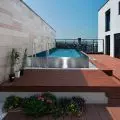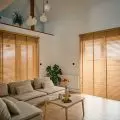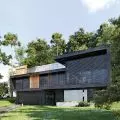When designing this house, the architects wanted to take advantage of the advantages of a plot of land that was difficult to organize. That's why the living zone was maximally opened to the external environment. We present the design of the house by BDR Architekci studio.
Opening to the outside was dictated not only by the use of the plot, but also by increasing the biologically active area. The house located in Konstancin-Jeziorna hides some more interesting technological solutions, its construction is hybrid. This means that the main aboveground structure is a steel skeleton supplemented with glulam(CLT) elements.
The opening to the outside was dictated not only by the use of the plot, but also to increase the biologically active area
© BDR Architects
Konrad Basan of BDR Architekci talks about how they tried to connect the building with the environment, why the terrace is so important and what the use of hybrid construction is all about.
Wiktor Bochenek: How did you want to connect the building with the environment?
Konrad Basan: Already after our first visit to the plot, we knew that we wanted the building to open up to the surrounding nature as much as possible. The plot is located in Konstancin-Jeziornain a neighborhood of bungalows and single-family houses. Given the beautiful, partially wooded landscape, we decided that the house and its openings should not frame it, but rather allow it to permeate the interior.
The living area was opened up as much as possible to the outside environment
© BDR Architects
Wiktor: An important element is the terrace, how did you organize it?
Konrad: The terrace surrounds the building on three sides on the first floor and the first floor, it is a kind of buffer - a semi-open space. It is an extension of the usable area and is accessible from all rooms of the building on both levels. In addition, the upper terrace shades the living area on the first floor preventing the rooms from overheating in the summer. This creates ideal conditions to open all the sliding windows in the living room on warm days and connect the garden space in front of the building with the living zone inside.
The terrace is an important element of the whole design
© BDR Architects
Wiktor: How was the layout of the house designed? What is worth paying attention to here?
Konrad: The building has a clear plan close to a square. The southern, bright part contains the main, open usable spaces of the house - the living room area with kitchen and dining room on the first floor, a spacious bedroom and children's room on the first floor. The northern part contains auxiliary rooms, such as bathrooms, communication, dressing room, and study rooms. The layout clearly dividing these two parts of the building refers to the "Kahn" division of space into servant spaces (served sapces) and servant spaces(servant spaces).
interior of the house
© BDR Architects
Victor: The structure is hybrid? What does that mean and how does such a solution differ?
Konrad: In the building we used a steel frame as the main load-bearing structure. This allowed the free formation of large openings, especially in the living area of the first floor, and thus enabled the consistent implementation of the concept. The underground part of the building and the shaft of the staircase were made as, reinforced concrete. In this way, the steel structure has a proper foundation, is stiffened and does not require additional bracing. The exterior walls were made using wood frame technology with a cladding of milled fiber-cement panels.
interior of the house
© BDR Architects
Wiktor: How was your relationship with the investor?
Konrad: One could say that it was a dream collaboration. Already after the first presentation of the concept and sketches, the investor showed a lot of trust and was open to many unconventional solutions. The design process went very smoothly and subsequent stages consistently implemented and detailed our initial conceptual assumptions. This resulted in a coherent and individual project tailored to the needs of the Investor.
The investor showed great trust and was open to many unconventional solutions
© BDR Architects
Wiktor: What caused you the greatest difficulty in this project, and what gave you the greatest satisfaction?
Konrad: The biggest challenge was definitely the layout of the functional program on the plot and in the building. The relatively small plot of land and the development parameters resulting from the local plan introduced size limitations. This dictated the creation of a compact body and a very efficient layout of the projection. The greatest satisfaction, therefore, was to create a compact design, but with a rich and varied range of interior and exterior spaces. The result was appreciated by the Investor, which was an additional source of this satisfaction.
Wiktor: Thank you for the interview.
ideogram of the house
© BDR Architects








































